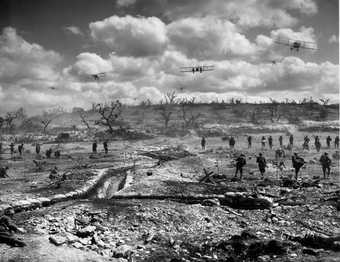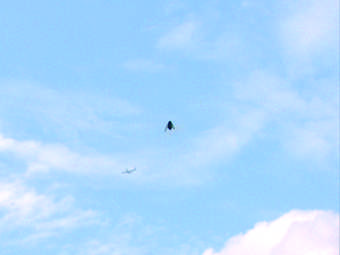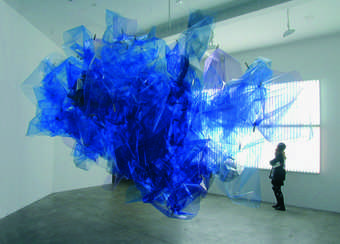When Yves Klein famously ‘signed’ the sky while lying on the beach at Nice on a summer afternoon in 1948, he claimed the gesture as his first and greatest artwork. He described it some years later as ‘a fantastic realistico imaginary journey’ into the stark blue void that by then he had transformed into a patented trademark, International Klein Blue (IKB), the colour of “the other side of the sky”. But his first journey into the monochrome void had not been without its frustrations. ‘As I lay stretched upon the beach,’ he recalled, ‘I began to feel hatred for the birds which flew back and forth across my blue sky, cloudless sky, because they tried to bore holes in my greatest and most beautiful work. Birds must be eliminated.’
Klein’s anti-bird’s-eye view of the sky as a vaulting curtain of hallucinatory colour can be seen as a secular incarnation of the early Christian painterly tradition in which the celestial sphere – the realm of the divine – is set at a remove from its earthly dominion through the application of a gold leaf background. In early icons and altarpieces those shimmering skies registered immanent divinity, while carefully screening its presence from our eyes. The realm of the infinite remained unseen. By the later Renaissance in Europe, however, philosophical and artistic engagements with the material world had begun to open up the idea of the sky as a mutable arena in which aleatory events, such as clouds passing before a rising moon, reflected the changeable circumstances of life on earth. By the time Jan van Eyck produced The Crucifixion c.1430, the sky was no longer a void but a plenum – a space filled with moving matter – which artists would increasingly employ as a temporal register of times of day, of weather conditions and, above all, of prevailing mood and atmosphere.
The word atmosphere means ‘the sphere of vapours’, and its early application to works of art was in recognition of the nebulous origins of the creative impulse – ‘vapour’ is an ancient metaphor for the imagination – as well as the atmosphere’s physical role as the conduit of light and air. It is the sky, not the land, that keeps us alive, and from which inspiration flows (to inspire is, literally, to breathe in air), a conjunction that appears to have preoccupied many painters from the European landscape tradition. The clouds in Constable’s Old Sarum 1829, for example, mass over the scene with an energy of purpose that is entirely absent from the Iron Age ruin below. Constable was a painter not of landscapes but of atmospheres, a circumstance reflected in the claim made by Ruskin in 1856, that ‘if a general and characteristic name were needed for modern landscape art, none better could be invented than ‘the service of clouds’.

William Wellman
Wings 1927
Film still
© AMPAS
The advent of photography in the mid-nineteenth century brought a new documentary focus to the sky, due in part to the practical difficulties inherent in the technology. Because early landscape photographers employed minutes-long exposures, their over-exposed skies lacked all definition. The solution, to which many practitioners resorted, was to take separate, under-exposed prints of the sky and then superimpose them over the whited-out originals. Roger Fenton’s September Clouds 1859 is an example of just such an expedient sky, shot to supply his studio with cloudscapes to order. Early filmmakers faced similar problems when they turned their cameras to the skies. In 1927, the director (and ex-flying ace) William Wellman began work on his first dogfight movie, Wings, vowing that not a frame of his picture would be faked indoors. All shots of aerial combat, using borrowed US Air Force planes, would have to be filmed in the air. But the skies of Texas, where filming was about to begin, remained cloudless for weeks on end, holding up the shoot at enormous expense. After a month had passed, Paramount despatched an executive to Texas, who demanded to know why you can’t film dogfights in the absence of clouds. Wellman’s reply was characteristically concise: ‘First, it’s unattractive. Number two, you get no sense of speed because there’s nothing there that’s parallel. The clouds give you that, but against a blue sky, it’s like a lot of goddamn flies. And photographically, it’s terrible.’ Eventually, the clouds put in an appearance and Wings was completed to Wellman’s satisfaction, but the vexed issue of perspective in the sky has continued to preoccupy photographers ever since. John Baldessari’s photo-essay Throwing Three Balls in the Air to Get an Equilateral Triangle 1972–3 and Mark Wallinger’s video Fly 2000, in which a far-off plane makes a brief visual rhyme with a fly stuck on a suburban window, both deploy the lack of scale inherent in a featureless sky as a deliberate obstacle to composition, so that any group of objects will end up looking – as Wellman had said – ‘like a lot of goddamn flies’.

Mark Wallinger
Fly 2000
Film still
© Anthony Reynolds Gallery © Mark Wallinger
The development of aviation has exercised a powerful impact on the way that artists inhabit their skies. In Prima che si apra il paracadute 1939–40 by the Futurist aeropainter Tullio Crali, a statuesque airman falls through the clouds towards a distant and fragmented earth, enacting an apotheosis in reverse, while in Peter Lanyon’s Thermal 1960 the invisible spiralling up-currents that Lanyon encountered during his years as an amateur glider materialise into a vortex of paint. In both cases the viewer is positioned high in the sky, in exhilarating freefall, face to face with the powerful dynamism of air. Paul Nash’s iconic Battle of Britain 1941, by contrast, narrates from a detached perspective the means by which warfare seeks to erase that dynamism, overwriting the natural sky with elaborate new patterns of destruction. Traceries formed from smoke and contrails overwhelm the fragile clouds, which on closer inspection turn out not to be clouds at all, but exploding anti-aircraft rounds. The instruments of battle have combined to create a new kind of hybridised sky, of a sort that is eerily recalled in Rachel Whiteread’s series Demolished 1996, in which the dust-clouds formed from the destruction of a London tower-block rear up to join the weather clouds above, a dark new species of menacing skyscape emerging from an act of urban renewal.
But where, in a multi-horizoned world, does the sky really begin and end? Like Nash’s war-clouds, Whiteread’s billowing updrafts belong not to the natural realms of air, but to the man-made atmospheres that overshadow all dystopian futures. The domed (and usually doomed) communities that inhabit alien biospheres in classic science fiction reflect our own growing anxieties about pollution, air-raids, skin cancer, meteorites, climate change and airborne terrorism, which, over the course of the twentieth century, combined to locate the idea of annihilation securely in the sky. Interior atmospheres are safer by far: James Turrell’s first Skyspace work, Lunette 1974, for example, was a glass frame set into the roof of the Villa Panza in Varese, which acted as a portal through which passing clouds could be viewed from the sanctuary of the gallery space. Any threat posed by exterior disturbances – wind, rain, the sun going nova – would be neutralised by the calm of the evenly-lit interior. Turrell’s soon-to-be-completed installation, the Roden Crater Project (begun in 1977), represents a further retreat behind the refuge of the frame, transforming an extinct volcano in the Arizona desert into a vast observatory, complete with underground tunnels and chambers through which visitors can gaze up at the celestial vault as it changes with the turning of the earth. The crater’s carefully levelled-off rim acts as a kind of giant lens through which the familiar dimensions of time and space appear magnified and unreal, offering glimpses into the far-off skies of past and future worlds.
According to Judeo-Christian tradition, time and weather both resulted from the Fall, the sins of Adam and Eve having deprived them of immortality – leading to the birth of human time – while banishing them to a world that had been tilted on its axis, the catastrophe that gave rise to the seasons. But Turrell’s distorting lens, aimed at the skies above Arizona’s paradisiacal Painted Desert, attempts to circumvent this temporal banishment, and thereby return us to our lost celestial Eden, to Yves Klein’s ‘other side of the sky’. It’s a desire that has motivated artists for millennia – what else were those gold leaf skies but visions of Elysium? – and it clearly continues as a preoccupation today. Verne Dawson’s Cycle of quarter- day observances, circa 23800 B.C., When Santa was a Shaman 1999, for example, takes us on a journey of calendrical recovery through the vastness of astronomical time. Set during an era when the earth’s axis was at exactly the same degree of tilt as it is today (23.4), the skies of all four Cycle canvases are simultaneously, then and now, spanning a year’s worth of seasons that are at once contemporary and prehistoric, unveiling the patterns made in the sky by slow cyclical changes in the angle of the earth. As in Constable’s earlier vision of the cloud-haunted ruins of Old Sarum, Courtesy Ed Ruscha Studio/photograph: Paul Ruscha ground down by 5,000 years of weather, a dizzying sense of continuity is registered through a skyscape that functions as a portal into the remote human past.

Spencer Finch
Sunlight in an Empty Room (Passing Cloud for Emily Dickinson, Amherst, MA, August 28, 2004) 2004
© Courtesy Brändström & Stene Gallery © Spencer Finch
Such multiple layerings of time and space are subjects to which the American conceptual artist Spencer Finch has also devoted much of his work. His most recent exhibition, As much of Noon as I could take between my finite eyes, takes its title from a poem by Emily Dickinson. It centres on the 2004 light piece Sunlight in an Empty Room (Passing Cloud for Emily Dickinson, Amherst, MA, August 28, 2004), which seeks to re-create the exact weather conditions that the artist experienced during a visit to the Emily Dickinson Homestead museum, the two-storey colonial mansion on Main Street, Amherst, that the reclusive, possibly agoraphobic, poet rarely left during the last 30 years of her life. The piece features a bank of 100 fluorescent lamps, their combined light matching the precise colour of sunlight that fell in the museum’s backyard on 28 August 2004, the date of Finch’s visit. Next to this light source is a tangle of blue filters held together with clothes pegs, which casts exactly the same shadow, both in colour and shape, as did a solitary cloud that passed overhead that same afternoon. Three distinct time frames the present moment, the day of Finch’s visit and the moment of the poem’s conception in the 1860s – coalesce in Finch’s cloud-shadowmachine to form an endlessly recurring interior sky, in memory of a poet who spent much of her life gazing out from an upstairs window.
Dickinson’s skies, mediated through glass, reveal a recognisably modern disposition. Like Patrick Caulfield’s Small Window 1969, or Andreas Gursky’s Schiphol 1994, they reflect a kind of deadpan indifference to the fortunes of the outside world. They are the skies beneath which a modern civilisation advances, screening us from aleatory ‘meteors’ (the ancient word for weather events, hence ‘meteorology’), while replacing them with a range of technological equivalents: satellites, radio signals, text messages, security frequencies. They are skies vibrating, day and night, with an invisible topography of disturbance. The British architect Usman Haque, disquieted by the scale of our hertzian environment, devised an aerial listening post in the form of a remarkable sound installation, Sky Ear 2004, a cloud of 1,000 helium balloons launched into the evening sky with a payload of mobile phones, sensor circuits and flashing LEDs. The phones are set on auto-answer, allowing you to call them up and listen to the sounds of the troposphere. What emerges is an eerie symphony of whistles and hums picked up from the electromagnetic Babel that fills the sky like an artificial atmosphere, your call from the ground supplying a momentary connection to the stream of man-made weather that passes overhead, keeping the machinery of civilisation alive.
